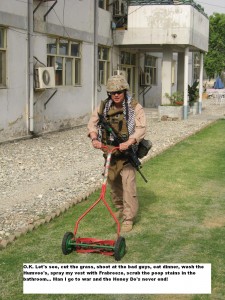New message from LtCol Asad Khan USMC (Ret.)
November 3rd, 2009 Posted in The SandGram v1.0Afghanistan – Ideas From The Outside
LtCol Asad Khan, USMC (Ret.)
October 2009
While there is an on-going debate on Afghanistan and the need for more
troops (or not), it is imperative that we look at other options which are
critical for the long term solutions – troops by themselves will not
succeed. These observations came about from a recent journey along the Ring
Road and discussions with local Afghans (outside Kabul) – where the
perspective is far different than Kabul, DC or a FOB.
RING ROAD: The Ring Road and other major routes are key to determining the
future of Afghanistan. Recently, I travelled the Ring Road and it was
evident that this artery is the strategic boundary between the opposing
sides. The Ring Road, peppered with mine craters was still busy with buses,
trucks and private cars bravely navigating the dangers to get to their
destination. I noticed limited ANA and ANP presence patrols along the route
providing over watch to a convoy of over a thousand tractor trailers heading
south from Kabul. Keeping it open is vital to the economy.
We cannot secure all of Afghanistan, it is militarily impossible. Therefore,
Coalition Forces with ANA / ANP / APPF and Private Security Companies should
secure the Ring Road and other major routes along with surrounding
population centers. This will increase commerce and economic opportunity for
the locals. Once the security for the major commerce arteries is
established, the focus should then be to expand outward towards the borders
and inwards to the Central Provinces.
While the focus is on the major arteries, special operations / strike forces
can operate in other areas to disrupt the enemy and engage high value
targets.
CALL TO ACTION: Recruit successful International businessmen to help grow
the Afghan Economy by mentoring existing businesses and providing business
executive education classes focusing on entrepreneurship, financial
management, business development and corporate compliance. If Afghan
companies join this mentorship program they would be eligible to compete for
USG contracts and Afghan Small Business Loans.
TRADE & INVESTMENT MISSIONS: Encourage American and European Companies to
partake in such missions to Afghanistan. There is no point in holding
conferences in Dubai or DC to which an average Afghan has no access. We need
to go where we are most effective. Recently there was a major COIN
conference held in DC where they talked about Afghanistan. What better place
to hold it than Afghanistan — and invite the locals and ask them how to
defeat the insurgency.
AFGHAN FIRST INITIATIVE: This can’t be a bumper sticker – we need to
implement this now! For the past eight years international companies have
made huge profits from the aid money. Nearly 80 percent of all aid money
never stays in Afghanistan. This frustrates the Afghans when they see the
“expats” getting higher salaries and standard of living from the aid money
meant for the Afghan people. We need to stop breast feeding the Afghan
people. They are very industrious and can figure out how to do things much
quicker. In fact most of the hands on construction is done by Afghans while
international companies provide the managerial oversight and drawing the
high salaries and profits. By allowing the Afghans to do the work directly
we will get more bang for the buck and create greater economic stimulus.
CONTRACTUAL OBSTACLES: US Government Contractual Regulations are too
cumbersome and not effective in an environment where the illiteracy rate is
90%. We need to streamline these to the important task at hand – sending out
request for proposals where the first 60 pages cover the Federal Acquisition
Regulation is absurd – Afghans can’t digest it. For that matter, most
educated people can’t either. One can make the point that these are designed
to ensure compliance and minimize corruption. If so, we failed in Iraq and
are failing in Afghanistan. We need rules that allow people to make
decisions, ensure local compliance and help the Afghan contractors succeed –
not navigate failure.
MORE CIVIL CONSTRUCTION: The general perception by the locals is that all we
are doing is pouring the aid money into military FOBs and Facilities at the
expense of the people. Driving around Afghanistan, one can see why. We need
to turn the equation around and focus more on the people’s need – not the
ANA / ANP or our FOBs – which provide the comforts and meals of back home
(combat is not meant to be comfortable).
FOCUS ON GOVERNANCE: Right now the perception is that the Taliban are
actually protecting the people from corrupt government officials, ANA and
ANP – and in some cases the Coalition Forces. The notion that we are
protecting the people is miscued as many believe that the coalition forces
are now protecting the people from their own missteps – while corruption
rules the day. We need to change this by holding those we fund accountable
to a higher standard than the Taliban. We have no option but to earn back
the trust of the people. Afghanistan, like many countries in the region, has
an endemic corruption problem which has become part of its cultural fiber.
Afghans by themselves cannot succeed in fighting corruption. This will
require outside intervention from us – whereby we hold officials accountable
because we pay them and they are misusing our money.
NATIONAL ACCOUNTABILITY: A National Accountability Bureau should be
established under international supervision and authority to investigate
allegations of corruption against government, military and police officials.
Those found to be corrupt or misusing their authority should be held
accountable.
DRUG TESTING: A large portion of the ANA and ANP are using drugs. This needs
to be stopped through vigilant drug testing programs similar to the one that
the US military has. There have been reports of coalition troops trading
military equipment for drugs (like the Soviet troops used to do) – we should
implement an aggressive drug testing program for coalition troops in
Afghanistan as well – after all 90% of the world’s heroin supply comes from
there.
TALIBAN PAYS MORE: Despite the recent pay increase to ANA and ANP, an Afghan
can make more money by joining the Taliban through direct pay and Zakat –
plus he stays in his local area so the Taliban does not have an AWOL or a
morale problem.
REGIONAL REGIMENTS: The ANA is generally not well received by the locals –
especially in the South if it has Tajiks and Uzbek soldiers. Aside from the
corruption and drug issues, the locals don’t like other ethnic groups coming
into their homes. In trying to make the ANA ethnically balanced we have
created public animosity and a rally cry for the Taliban. We should follow
the British Raj model and have Provincial / Regional Regiments consisting of
troops from the region where they serve.
CONTINUING EDUCATION: Afghanistan is severely lacking college seats for the
young and upcoming Afghans. We need to fund / encourage universities from
the US / Europe and neighboring countries to open satellite campuses. These
need to be established in all the major cities. We can’t afford to lose
another generation. Similarly, we need to fund scholarship programs for
worthy Afghan men and women within Afghanistan and overseas.
MICRO AIRPORTS: In the 1960s, Pakistan could not afford modern
infrastructure and roads into remote regions. So to open up the country,
they built micro airports – 3000 foot runway and a tower to allow small
propeller passenger airplanes to land and take passengers to larger
international airports. This allowed labor to go to the Middle East and
work. In return they sent foreign exchange back home which created a demand
for goods and services and subsequently generated revenue for the government
to build roads and other infrastructure. Same needs to be done in
Afghanistan. A country of its size and remoteness cannot function with only
seven airports; each province needs a small airport linking it to Kabul,
Kandahar, Mazar and Herat. These airports can be built for approximately $5
million a piece. This entire program would be approx $150 million and would
open up the country, linking the provinces to the central government and
allowing the people to participate in a broader economy.
AFPAK: The path to success in Afghanistan is through Pakistan. The two are
inseparable given the nearly 40 million Pashtuns between the two nations –
and their common history, language and culture. For the past eight years we
failed to link the two while allowing the blame game to take over broader
strategic interests. We need to stop this childish blame game about who
should control the border and who is training whose Taliban. Both should
control the border and Taliban are entrenched on both sides. We need to look
for quick solutions targeting the border areas and the tribes on both sides
(not long drawn out USAID Programs that take years to materialize and make a
difference). We should consider the border area as a separate area of
operations where by military, law enforcement, civil and commercial actions
are coordinate – as one – on both sides.
CLOSING THOUGHTS: At the end of the day, the Afghan people must want it more
than we do – for them. They must tackle the hard issues and want to improve
their lives and institutions – rather than accept the status quo and
addiction to aid money as a panacea to their problems. As much as the World
wants to help Afghanistan, we need to do so in a manner that allows the
Afghans to get back on their feet rather than continue to become dependent
on foreign aid. In the last eight years we have made progress which is
clearly evident along the Ring Road and the flow of commerce – however the
recent reemergence of the Taliban has primarily been due to the people
outside of Kabul losing faith in their government officials to protect them
– to the contrary, the people have become victims of the corrupt government,
military and police officials. The notion of servitude and respect for the
population does not exist. Government officials have very little regard for
the general public – the ANA and ANP treat the people with little dignity or
respect. Affluent Afghans have embraced a VIP culture of Land Cruisers and
Kalashnikovs – whereby they operate above the norms of society further
alienating the population. This fragmentation has allowed the Taliban to
fill the vacuum by creating shadow governments in the provinces and
districts – they are more responsive to the needs of the people while also
providing the illusion of protection.
The question is, can the Afghans, on their own, turn things around or does
it require a greater role on our part. My assessment is that we need to
first address the core issues without which no matter how many troops we put
in country – as long as the population is alienated, we will not succeed.
Therefore, we need to intervene where the Afghan Government has failed – to
police its own. Although we must respect the Afghanistan’s sovereignty, we
must also understand its failures, lack of institutions and credible
leadership to succeed. The respect for sovereignty should not be a cover for
allowing rampant corruption, lack of accountability and lack of respect for
the Afghan people by the custodians of the nation – who to succeed must earn
back the trust of the people from the Taliban.
Asad Khan is a retired United States Marine Corps officer with over 25 years
of experience in South Asia and the Middle East. He was a Foreign Area
Officer, and he has fought twice in Afghanistan in 2001 and 2004. In 2004,
he commanded 1st Battalion 6th Marines during sustained combat operations in
central Afghanistan. He authored Genghis-6 about his experiences in
Afghanistan from 2001-2004, and he continues to work in the Middle East,
Afghanistan and Pakistan in various capacities. Please forward any comments
and professional discussion to: aa.khan@hotmail.com





